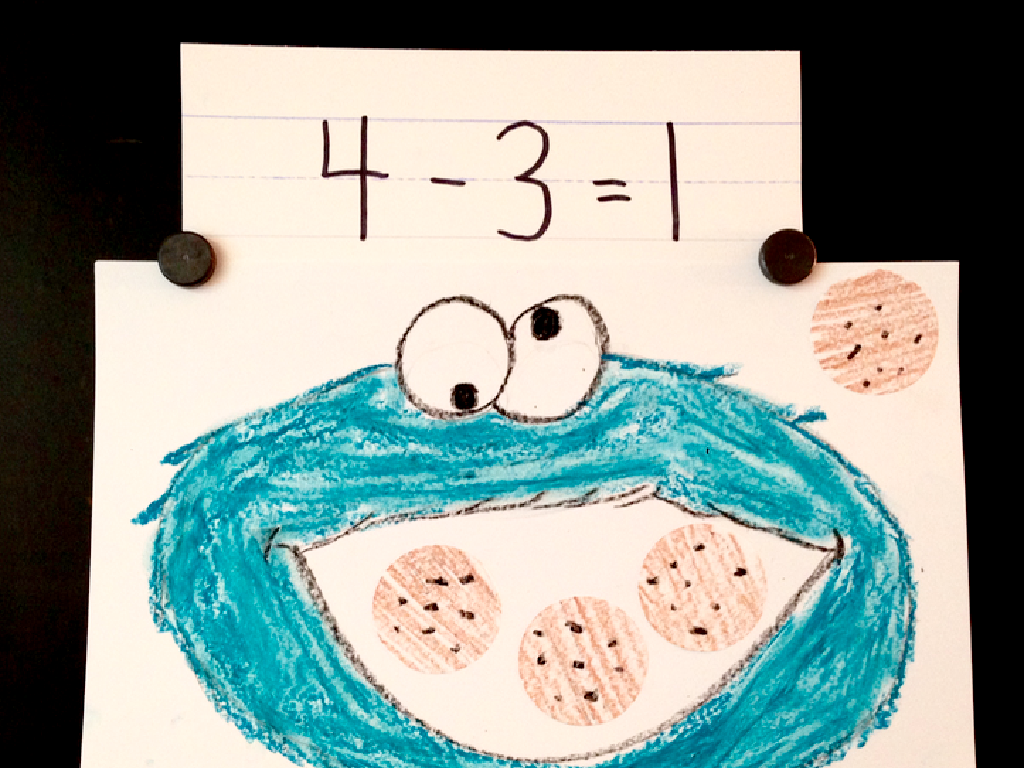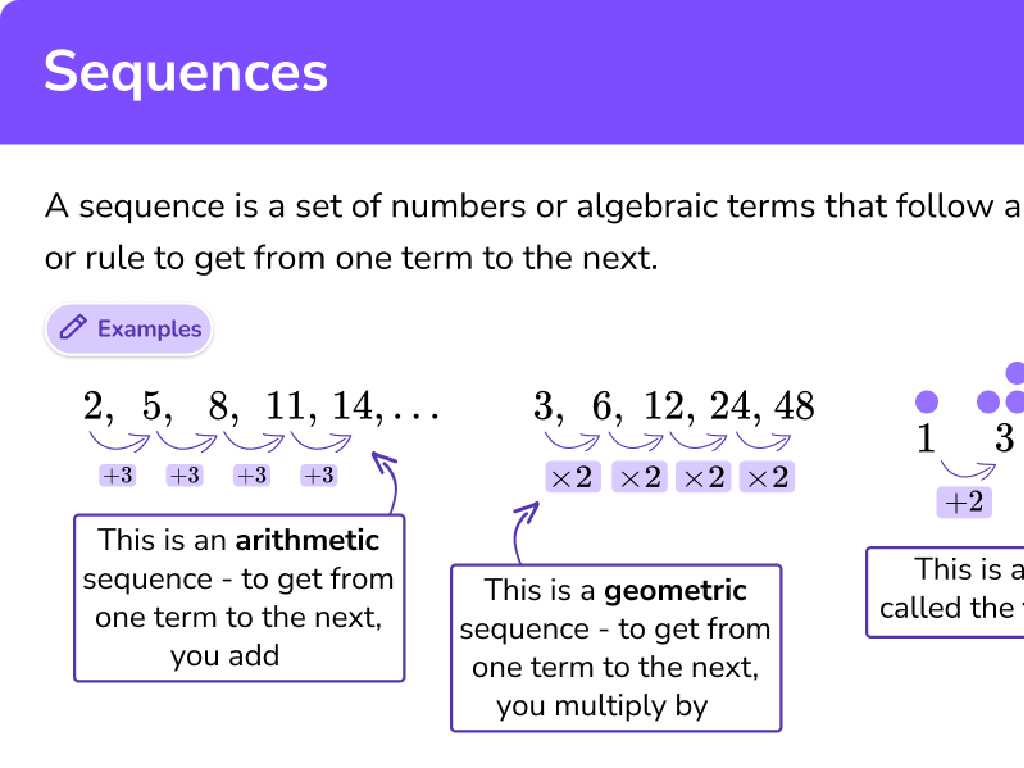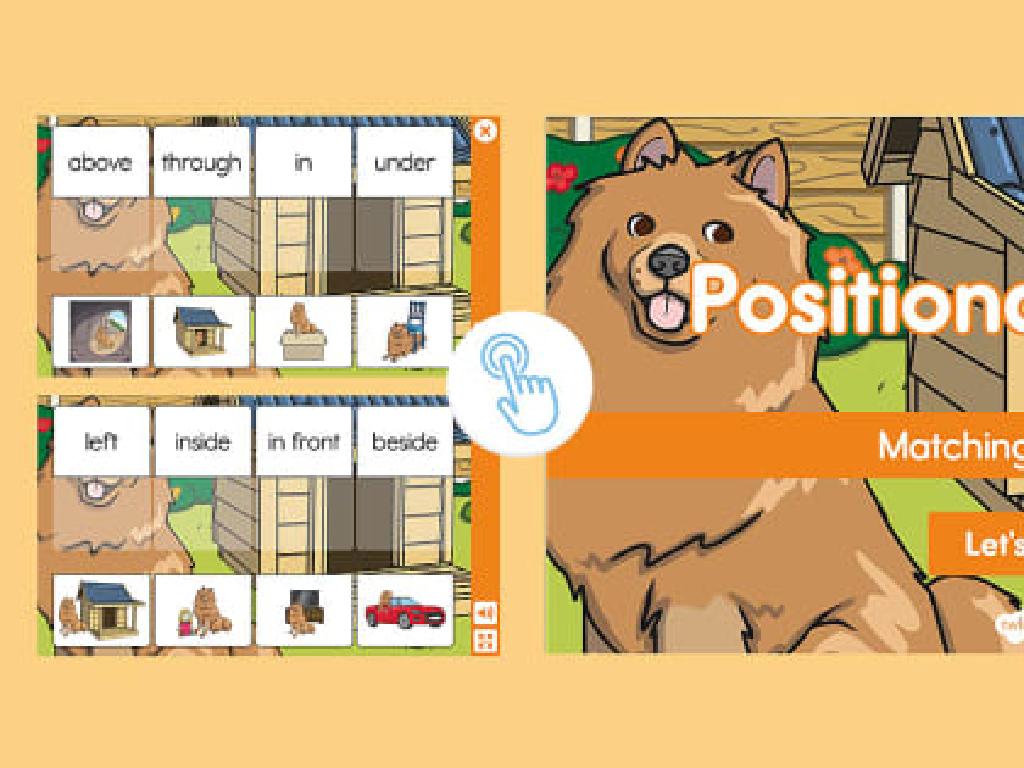Identify Halves
Subject: Math
Grade: First grade
Topic: Fractions
Please LOG IN to download the presentation. Access is available to registered users only.
View More Content
Welcome to Fractions: Learning About Halves
– Introduction to fractions
– Understanding parts of a whole
– Think of a whole as one thing, like a pizza
– Halves: Splitting into 2 equal parts
– If you cut something into 2 same-size pieces, each piece is a half
– Recognizing and making halves
– Practice by folding paper or cutting fruit evenly
|
This slide introduces first graders to the concept of fractions, focusing on understanding halves. Begin by explaining that fractions represent parts of a whole item or group. Use tangible examples like a whole pizza that can be shared equally among friends to illustrate the concept of a whole. Then, move on to explain halves by demonstrating how cutting or splitting one whole item into two equal parts results in each part being called a half. Provide hands-on activities such as folding paper or cutting play-dough to help students visualize and practice making halves. Encourage students to think of other examples of halves in their daily lives and be prepared to discuss these examples in the next class.
What Are Halves?
– Cutting things into 2 equal parts
– Each part is called a half
– One half is one of the two equal parts of a whole item or group.
– Halves make up a whole
– Sharing equally with a friend
– Like splitting a sandwich evenly so each person gets the same size piece.
|
This slide introduces the concept of halves to first-grade students. Begin by explaining that when an object or a group is divided into two equal parts, each of those parts is called a half. Emphasize that for something to be a half, the parts must be exactly equal. Use tangible examples like cutting an apple, sandwich, or a piece of paper to illustrate the idea of halves. Encourage students to think of other items they could share by dividing into halves. This will help them understand that each half is one of the two equal parts that make up the whole of something.
Identifying Halves
– Observing pictures for halves
– Spot objects cut into halves
– Look for objects divided into 2 equal parts
– Equal parts make halves
– Both parts must be identical in size
– Practice with real examples
– Use items like fruits or paper to demonstrate
|
This slide is aimed at helping first graders understand the concept of halves by visual observation and practical examples. Start by showing pictures of various objects, some of which are divided into halves and others not. Guide the students to identify which objects are cut into two equal parts, emphasizing that for something to be considered a half, each part must be the same size. Use real-life examples such as cutting an apple or folding a piece of paper to visually demonstrate the concept of halves. Encourage the students to explain why they think certain objects are or are not cut into halves to reinforce their understanding.
Halves in Shapes
– Shapes can be split into halves
– A circle can make two half-circles
– When you cut a circle down the middle, you get two halves that look like moons!
– Rectangles split into equal rectangles
– Cutting a rectangle in half across the middle makes two smaller rectangles, just the same size.
– Halves are two equal parts
|
This slide introduces the concept of halves using shapes, which is a fundamental part of understanding fractions. Explain that when a shape is split into halves, it is divided into two equal parts. Use visual aids like drawings or cut-outs of circles and rectangles to show how each shape can be divided into two equal parts. Emphasize that both halves must be the same size to be considered equal. Encourage students to think of other shapes that can be divided into halves and to practice drawing lines of symmetry on various shapes.
Understanding Halves
– Every whole can be split into halves
– Like cutting a pizza into 2 big slices
– One half is written as 1/2
– It’s like sharing 1 cookie with a friend
– 1/2 means one of two equal parts
– If you have 2 apples, 1 apple is half
– Halves make two equal shares
|
This slide introduces the concept of halves to first-grade students. Begin by explaining that any whole item, like a pizza or an apple, can be divided into two equal parts, which we call halves. Show them that we write one half as 1/2, which represents one out of the two equal parts. Use tangible examples like cutting a piece of paper or sharing treats to illustrate the concept. Encourage students to think of other things they can divide into halves. This foundational understanding of halves as equal parts of a whole will be crucial for their comprehension of fractions.
Finding Halves Around Us
– Halves in everyday life
– A half is one of two equal parts
– Cutting an apple in half
– Imagine slicing an apple into two same-size pieces
– Sharing a cookie evenly
– Think of splitting a cookie into 2 equal shares
– Discover more examples
|
This slide is aimed at helping first graders recognize and understand the concept of halves in a tangible and relatable way. Begin by explaining that a half means one of two equal parts of a whole. Use everyday examples like cutting an apple or sharing a cookie to illustrate this point. Encourage the students to think of other examples where they might encounter halves in their daily lives, such as dividing a sandwich or sharing a pack of crayons. This will help them relate the abstract concept of fractions to concrete experiences. During the next class, ask the students to share their examples to reinforce their understanding and to allow them to learn from each other’s observations.
Class Activity: Making Halves with Playdough
– Learn to make halves
– Use playdough for shapes
– Create circles, squares, and more
– Cut shapes into two equal parts
– Use a plastic knife or string to divide
– Both halves must be equal
– Check if both sides are the same
|
This activity is designed to provide hands-on experience with the concept of halves. Students will use playdough to create various shapes, such as circles and squares, and then use a plastic knife or string to cut these shapes into two equal parts. Emphasize the importance of making both halves the same size to understand the concept of ‘half’. Teachers should circulate the room to assist and ensure that students are correctly making halves. Possible variations of the activity could include using different colors of playdough for each half, comparing halves with different shapes, or even combining halves from different shapes to see if they are equal. This will help reinforce the idea that a half is one of two equal parts of a whole.
Review: Understanding Halves
– What are halves?
– Equal parts are important
– Both parts must be the same size to be halves
– Show and tell: halves examples
– Bring an item cut into 2 equal parts
– Why halves matter in daily life
|
This slide is meant to review the concept of halves that was taught in the lesson. Start by asking the students what they remember about halves. Emphasize the importance of having two equal parts to make a whole. Encourage students to participate by showing an example of an item that is split into halves, which could be a piece of paper, an apple, or a sandwich. This interactive approach helps reinforce their understanding. Conclude by discussing why knowing about halves is useful, such as sharing equally. For the activity, have different items available for students to split and explore, like playdough, fruits, or simple drawings they can color and cut.
Celebrating Halves Mastery!
– Congratulations on learning halves!
– Halves are two equal parts
– When something is split into 2 equal parts, each part is a half
– You’re now half-experts!
– Keep practicing with real objects
– Practice by cutting fruits or folding paper into halves
|
This slide is a celebratory conclusion to the lesson on halves. It’s important to reinforce the concept that a half means splitting something into two equal parts. Encourage the students to feel proud of what they’ve learned and to consider themselves ‘half-experts’. Remind them that practice is key to fully understanding fractions, and suggest fun activities like cutting fruits or folding paper to create halves. This will help solidify their understanding and allow them to apply the concept of halves in everyday situations.






